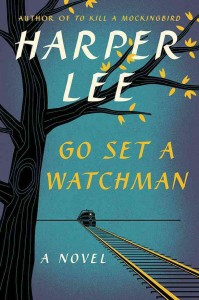Original article posted on July 15, 2015 in The Clarion-Ledger by Jana Hoops
 Tuesday’s long-awaited release of Harper Lee’s first novel since “To Kill A Mockingbird” 55 years ago was met with smiles, curiosity and mixed opinions as literary enthusiasts kept local book stores busy all day.
Tuesday’s long-awaited release of Harper Lee’s first novel since “To Kill A Mockingbird” 55 years ago was met with smiles, curiosity and mixed opinions as literary enthusiasts kept local book stores busy all day.
Despite Monday’s media leaks that “Mockingbird’s” beloved character Atticus Finch was portrayed in “Go Set A Watchman” as a “bigot” or “racist” — a far cry from his role as a defender of African American rights in Lee’s first book —readers seemed to shake off that possibility with a grain of salt, preferring to hold off judgment at least until they’ve digested it for themselves.
More than 125 people crowded into Lemuria Books’ nearby events venue, known as the “dot.com building,” as author and Belhaven creative writing professor Howard Bahr read the first chapter of “Go Set a Watchman” to the expectant audience.
“I don’t care about all that (controversy),” Bahr said. “To be chosen to do this tonight is an extraordinary privilege. I am deeply honored to be able to read this on its first release day.”
John Evans, owner of Lemuria Books in Jackson, said he has no worries that the pre-release hype touting a potentially racist character will discourage book sales.
If anything, Evans thinks it will fuel interest in the book. “Controversial labels arouse curiosity,” he said. “People should form their own opinions.
“ ‘To Kill a Mockingbird’ was a story set in the ’30s, written in the ’50s by a middle-aged woman. Scout (the main character) was able to look at her father (Atticus) through the eyes of a child. A child at that age thinks of her father as God’s gift. ‘Watchman’ is about a woman coming of age, and a grown woman’s perspective of her father is different.
“Also, you have to look at the cultural differences,” Evans said. “At that time in the South, people were only third generation away from the Civil War. I haven’t finished reading the book yet, but I’m not sure those people may have thought of (some of the things in ‘Watchman’) as being racist, as we probably would today.”
Maggie Stevenson, special projects coordinator for the Eudora Welty House, attended the event to get her copy and read it for herself before making any evaluations.
“This book is not a sequel to ‘Mockingbird,’ ” because it was actually written earlier, she said. “I’m reading it as a separate book,” she said.
“I have a theory. I think this book is really more autobiographical than ‘To Kill A Mockingbird.’ She (Lee) left her hometown and came back and found out she had different views from most people there, including her father, who she loved very much — and that’s why she wrote ‘Watchman.’ You write what you know.”
Local author and former Clarion-Ledger writer Jim Ewing — probably the only person at the event to have read the whole book (in one day) — called ‘Watchman’ “excellent.”
Ewing said there was “no question” that Atticus was racist “by today’s standards, but this was written half a century ago. By those standards in the South, he would be considered moderate or even liberal. The strength of ‘Watchman’ is that it’s a time capsule and openly displays characteristics we find ugly today, but it becomes a measurement for us for both good and evil.”


Comments are closed.